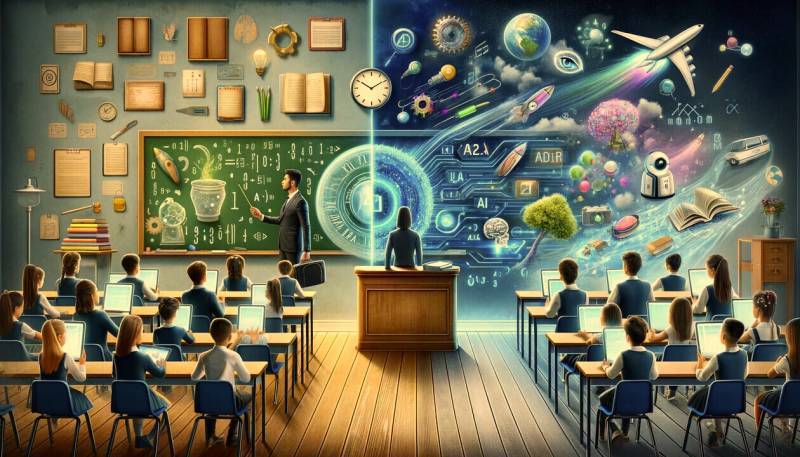
Dr.Rehan Rasheed Tanoli
In today’s rapidly changing world, resolutions are written not only in policies but also in algorithms and codes. Artificial Intelligence (AI) and Robotics have become the driving forces of progress, powering hospitals with intelligent diagnosis, transforming agriculture with automated systems, and reshaping industries with smart machines. They form the foundation of modern life, and their influence will extend to every field.
This raises a critical question for Pakistan’s education: Are we preparing our students for this reality, or are we leaving them behind in classrooms that belong to the past?
The reality is clear – AI and Robotics are not just subjects; they are the future itself. Yet, much of our education system still relies on rote memorization and exam-based learning. Students may achieve high grades, but they often struggle when asked to solve real problems, innovate, or think critically. To prepare a generation capable of competing in tomorrow’s world, Pakistan must design proper curricula for AI and Robotics, supported by fully equipped labs and innovation hubs. Classrooms alone are no longer enough. Children have the right not only to learn about new technologies but also to experiment with them. A student who builds a robot, codes a program, or tests an AI model in a lab environment develops a far deeper understanding than one who only reads from a textbook.
Globally, the importance of technology-driven education is well established. Countries such as South Korea, Singapore and China integrated robotics and coding into their education systems years ago and are now global leaders in innovation. Pakistan, with nearly 64% of its population under the age of 30, has a unique opportunity if it follows suit. If we fail to adapt, we risk being left behind while other nations accelerate ahead.
Delivering this vision requires action on two fronts: empowering students with tools to innovate and training teachers to confidently guide them. No reform can succeed if educators remain unfamiliar with the technologies they are expected to teach. Recognizing this, the Mediatiz Foundation, an Islamabad-based non-profit operating in the edtech sector, has taken a pioneering step by developing AI and Robotics courses tailored to Pakistan’s learners and coupling them with hands-on experiences. The foundation equips schools with robotics kits, coding platforms, innovation labs, and project-based learning models, while also focusing on teacher training to ensure long-term sustainability. This approach transforms classrooms into spaces of discovery, where ideas are tested, implemented, and shaped into real-world innovations.
Beyond such efforts, however, curriculum reform is essential. AI and Robotics must be treated as core subjects, not extras. Students should be assessed through projects and problem-solving tasks rather than exams alone. For example, designing a robot to help farmers or coding a chatbot for healthcare connects learning with real-world challenges.
The economic benefits are equally significant. Pakistan is already a top freelancing nation, but most young freelancers remain limited to basic digital tasks. Skills in AI and Robotics would allow them to move into high-value fields like automation, advanced analytics, and product design. Startups founded by such students could create jobs, attract investment, and strengthen Pakistan’s economy. Instead of exporting talent or brain drain, Pakistan could position itself as a regional hub for innovation. Of course, none of this is possible without infrastructure and teacher training. Labs, coding platforms and internet access are crucial, particularly in underserved areas. Teachers must receive continuous professional development so they can confidently demonstrate robotics, AI concepts, and coding. A well-trained teacher will inspire far more than any textbook.
Alongside technical knowledge, schools must also emphasize responsible AI and ethics. Children should understand the risks of misuse, data privacy concerns, and the importance of fairness in algorithms. This ensures that Pakistan produces innovators who are not only skilled but also socially responsible. Consider the potential impact if a student in rural Sindh builds a low-cost irrigation robot for farmers after learning robotics in school; another in Islamabad codes a chatbot that helps people access government services. These examples show that with the right education, Pakistani students can become innovators and problem-solvers for their communities.
The impact of such change would be far-reaching. By encouraging experimentation and practical projects, students would no longer be passive learners but active creators. They would gain confidence, curiosity, and resilience, the very qualities that define leaders of the future. Pakistan, with its young population, stands at a decisive point. We can either cling to outdated systems or embrace AI and Robotics education supported by modern labs and trained teachers to unlock the true potential of our youth.
The path is clear. Preparing learners today with the tools of tomorrow will not only secure their future but also strengthen Pakistan’s position in the global economy. But this transformation requires collective effort from the government, schools, parents, private organizations and international partners. The future will not wait, and Pakistan must not delay. ( Opinions expressed in this article are the author’s own and do not necessarily reflect WNAM editorial policy).


